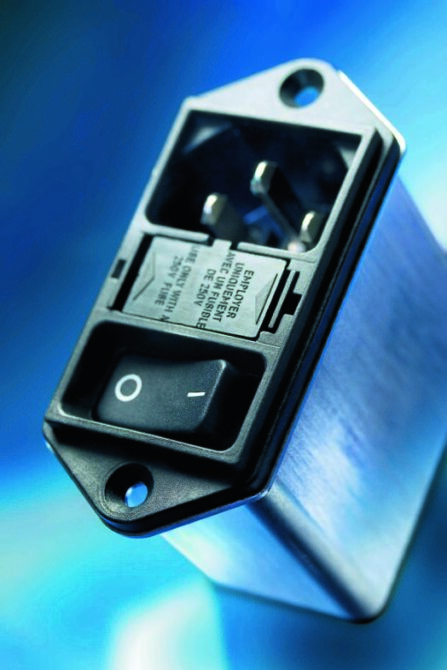
Safety in medical equipment starts with power input
By Schurter Inc.
Circuit Protection Electronics Interconnect Medical Input medical power SchurterIt is imperative that medical equipment does not pose any danger to patients or medical staff. A piece of equipment that causes a short circuit or residual current can trigger a protective system upstream and in doing so shut down other, possibly life sustaining, equipment. Thus, it is necessary to pay special attention to how each unit is supplied with power. Connectors and power entry modules used in the equipment are tested to component standards and if in compliance with these standards can generally be used in most equipment without additional testing. This is especially true for medical equipment, where extensive requirements regarding safety are in effect, as defined in the base standard for medical electrical equipment, IEC/UL 60601-1.
Power feed
Medical devices can be connected directly to the mains or with a detachable power cord. Such plug connections must meet the requirements of Standard IEC 60320. Depending on the application, it is recommended to include a mechanism to protect against any unintentional removal of the plug from the equipment’s power socket. The most common type of protection against inadvertent disconnection is a cord retaining bracket.
Fuse holders
Permanently installed medical electrical equipment comes with its own fuses. If there is a failure in a piece of equipment, a fuse prevents that unit from tripping the circuit breaker and disconnecting other, sometimes life-critical devices, from the mains. Equipment manufacturers must ensure that energized supply leads are protected by a fuse. A few power distribution networks, however, are not polarized. That means that the power plug can be inserted in such a way that the energized conductor can be on either the plug’s left or right pole. As a result, the equipment fuse could be protecting the neutral conductor, which results in no protection against a short circuit to earth. Therefore, it is recommended that all medical electrical equipment be equipped with a double-pole fuse holder. It must further be ensured that only authorized personnel can remove or replace fuses.

Source: Schurter
Switches
The line switch at the power feed has an important function. Just as with fuse holders, it must be ensured that the equipment is completely disconnected from the power network after being turned off. If only one pole in a non-polarized power distribution network is interrupted, the equipment could still be live. Thus, it is preferable to use a switch that disconnects the power feed on two poles.
Power-line filters
The power-line filter is a central protective element. It protects the equipment from external HF interference and reduces the HF interference radiated by the equipment. A power-line filter is often necessary to fulfill the EMC standards for CE declaration of conformity. Because power-line filters can be under constant voltage, they are subject to strict requirements:
- Leakage currents
Y Capacitors produce a leakage current to earth whose value depends on the component’s capacitance and the power-line frequency. This fault current can, if too large, trigger the fault interrupter whereby the power supply is shut off. Thus, touch leakage current for medical electrical equipment may not exceed 100µA under normal conditions, and for devices with direct patient contact, it even drops down to just 10µA.
- Capacitors
The capacitors used in power-line filters must meet strict criteria. They are wired directly between the energized conductors (X capacitors) or between the energized conductors and earth (Y capacitors). Common equipment standards such as IEC 60950 (IT equipment) require that capacitors between a phase conductor and the neutral conductor be at least Class X2, and capacitors between phases/neutral and the earth conductor be at least Class Y2. For medical electrical equipment without direct patient contact (MOOP), Class Y2 capacitors to earth are sufficient; for equipment with direct patient contact (MOPP), Y1 capacitors are required. (See IEC 60601-1: 8.5.1.) Capacitors store energy corresponding to their value of capacitance. If you pull a power cable out of a power socket, the stored voltage from the X capacitors is still present on the power pins.
- Dielectric strength
Increased dielectric strength is required for medical applications. An important safety aspect for achieving high dielectric strength consists of the distances between voltages. The base standard for medical electrical equipment, IEC/UL 60601-1, specifies air and creepage distances of at least 3mm between energized parts of different polarities and 4mm between energized conductors and earth. Care is required here because various UL standards allow a smaller separation in these distances than does the IEC standards. A power socket compliant with IEC 60320 fulfills medical requirements, while sockets compliant with UL 498 do not have sufficient air and creepage distances to meet the requirements of IEC. The UL 498 standard for plugs and sockets specifies only a 1.2mm separation between energized parts of different polarities at a rated voltage of 250Vac max. In contrast, for the same components, IEC 60320 requires 3mm as does the base standard for medical electrical equipment IEC/UL 60601-1.
As a safety test, the base standard for medical electrical equipment specifies a high-voltage test of 1.5 kVac between L and N as well as between L/N and earth (PE). To PE, the 1.5 kVac corresponds to the values of the filter standard and can be met without any problem. However, a filter between L and N should not be tested with 1.5 kVac because its capacitors could be damaged. Therefore, here IEC/UL 60601-1 makes an exception for interference suppression capacitors, which can be removed for a high-voltage test if they have been tested to IEC 60384-14.
—————————-
This article was written and submitted by Schurter Inc., a Swiss multinational manufacturer of electrical and electronic components. https://www.schurter.com/
